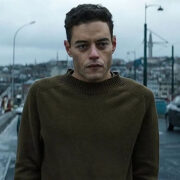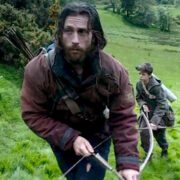Horrific Inquiry: THE RING (2002)

Stephanie Archer is 39 year old film fanatic living in…
Welcome back to the scariest, and at times goriest, column here at Film Inquiry: Horrific Inquiry. Twice a month, I will be tackling all things horror, bringing two films back into the spotlight to terrify and frighten once more. And occasionally looking at those that could have pushed the envelope further. Join us as we dive deep into the heart of horror, but warning, there will be spoilers.
“She never sleeps.” – The Ring (2002)
With the success of the J-Horror subgenre, it was inevitable that American remakes would grace our screens. And while many of these remakes had variable success, none found quite the level of success as Gore Verbinski‘s The Ring. The Ring terrified audiences alike, Samara finding a new audience to haunt, the success of the remake spawning further sequels for the franchise in the years that followed – even a television series.
Yet, as I returned to the film for the first time in decades, I remembered being more terrified the last time I watched The Ring. This is not to say the familiar chill up the spine and the avoidance of reflections did not come rushing back, but the film had lost some of its effect over the years since its release. Though, even in the face of time, it is clear to see why The Ring never sleeps.
Opening
The opening of The Ring immediately feels that of a 90s slasher film. From style to construction, it basks in the success of the reinvigorated genre horrors of the previous decade. As much of the film leans on its source material, it also welcomes the influence of horrors before it. Wes Craven feels alive in the opening sequence, while Death comes to life in a fashion similar to Final Destination. And even Alfred Hitchc*ck‘s Rear Window feels present, a high-rise panning of apartment windows and their inhabitants landing on a man in a wheelchair with a cast on his leg.

Immediately opening on two teenage girls, The Ring is quick to introduce its central premise – a tape that when watched leads to your death in seven days. As Becca (Rachael Bella) relays an urban legend to Katie (Amber Tamblyn), the story begins to take on truth, Katie’s face dissolving with each facial expression. Katie eventually reveals to Becca that a week ago that evening, she and her boyfriend watched the tape, a call coming through immediately after revealing she will die in seven days.. After the crux of the legend is revealed, the film toys with its audience, threatening jump scares and lingering threats in the shadows as Katie moves through the home. Yet, as soon as she is alone, the true terror begins to set in.
It was this opening sequence that drew me back into The Ring this month, Netflix’s social media account using it to promote the recent streaming option. It drove me right back to the eerie feeling I had experienced the first time I had watched it, all while reinforcing a return to the 1990s and 2000s horrors I have a deep affection for. And as the shared social media clip came to an end, I found myself diving back into the mystery that is The Ring.
Building a Mystery
Retrospectively, that is what The Ring feels like – a mystery. While this does not mean the film falls outside of the horror genre, I was surprised however to see how deeply rooted it was in the crime mystery of Samara and the existence of the tape. I remembered more gore, more jump scares and more terror. Watching the film again, it felt more subdued than my memory afforded me, and more heavily focused on creating and understanding why this was happening to each person that became a witness to the tape. In the end, it creates the perfect whodunnit wrapped in the terrifying fibers of horror.

After the opening sequence, The Ring takes on a green hue grayscale that retains the eerie feeling the opening introduces. It’s almost surreal, feeling as though the characters have entered a whole other world. As an audience, we are quickly introduced to the parallels of Rachel’s (Naomi Watts) and Samara’s (Daveigh Chase) parents, the first instances of a child needing to be heard encompassed in Aidan (David Dorfman). We quickly learn he excels in independence for a child his age, oftentimes speaking more through his drawings than conversation. The Ring utilizes these aspects of Aidan to heighten the fear the film wants to generate and maintain, his drawings speaking to a foresight of death and ominous conclusions.
Following the death of Katie, Rachel is enlisted by her sister to find out what happened, Rachel’s job as a journalist giving her an edge to find out more information than the family ever could. With a clear obsession of the job and a devotion to family, in the best way she knows how, Rachel dives into the research, Aidan’s ominous words and drawings filtering through the haze that builds throughout the film, providing clarity within the mystery. Pulling in former flame Noah (Martin Henderson), The Ring works on a fairly small cast of characters, leaving less of a body count in its wake and more of a horror built through mood, score and dialogue.
The score from Hans Zimmer will get under your skin, driving the fear of an unseen evil throughout the entirety of the film. Visually, the two dead and mutilated bodies are terrifying in their construction, yet have lost some of the effects of their jump scares over time. Much of this can be attributed to the cultural saturation following the success of The Ring. Yet, where some of these visuals have lost their effect, others have not.

I still found myself gagging as Rachel pulls the hair from the back of her throat, its transformation to an electrode working to horrify and further drive its mystery. And the horse scene on the boat to the remote island still holds its effect, its death one of the most brutal and hard-to-watch moments within The Ring.
Conclusion:
The mystery of Samara and the tape is well-paced throughout The Ring, giving only what the audience needs and sidestepping the need for too much hand-holding. Yet, watching the film again, I found myself desiring tighter editing, The Ring utilizes an overabundance of filler to capture the research, information, and travel time of its characters. In these moments, the film felt the heaviest and most burdensome. And where audiences in 2002 may have welcomed the reprieve, its utilization has lost its effect since its release.
Yet overall, The Ring still shines in its own era of horror, bringing to Western audiences the terror of the J-horror while still remembering the masters that have come before it. It may not stand against the test of time in all that it has to deliver, but The Ring still proves to audiences why it never sleeps.
Watch The Ring
Does content like this matter to you?
Become a Member and support film journalism. Unlock access to all of Film Inquiry`s great articles. Join a community of like-minded readers who are passionate about cinema - get access to our private members Network, give back to independent filmmakers, and more.












